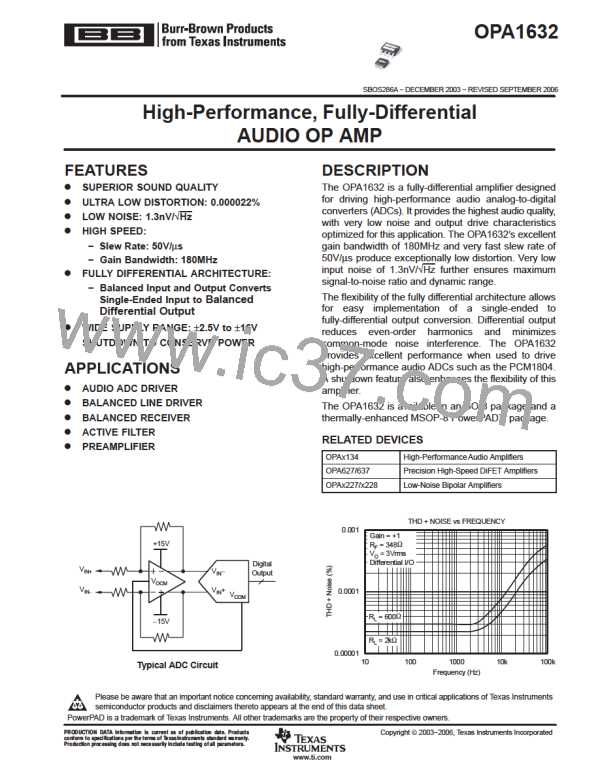ꢂ ꢀꢉ ꢠꢡꢢ ꢣ
www.ti.com
SBOS286A − DECEMBER 2003 − REVISED SEPTEMBER 2006
For systems where heat dissipation is more critical, the
OPA1632 is offered in an MSOP-8 with PowerPAD.
The thermal coefficient for the MSOP PowerPAD
(DGN) package is substantially improved over the
traditional SO package. Maximum power dissipation
levels are depicted in Figure 5 for the two packages.
The data for the DGN package assumes a board layout
that follows the PowerPAD layout guidelines.
POWER DISSIPATION AND THERMAL
CONSIDERATIONS
The OPA1632 does not have thermal shutdown
protection. Take care to assure that the maximum
junction temperature is not exceeded. Excessive
junction temperature can degrade performance or
cause permanent damage. For best performance and
reliability, assure that the junction temperature does not
exceed +125°C.
The thermal characteristics of the device are dictated
by the package and the circuit board. Maximum power
dissipation for a given package can be calculated using
the following formula:
MAXIMUM POWER DISSIPATION
vs AMBIENT TEMPERATURE
3.5
θ
θ
_
JA = 170 C/W for SO−8 (D)
_
JA = 58.4 C/W for MSOP−8 (DGN)
3.0
2.5
2.0
1.5
1.0
0.5
0
_
TJ = 150
No Airflow
C
Tmax * TA
PDmax
+
MSOP−8 (DGN) Package
qJA
(1)
Where:
P
is the maximum power dissipation in the
Dmax
amplifier (W).
SO−8 (D) Package
T
is the absolute maximum junction
max
temperature (_C).
−
−
15
40
10
35
60
85
T is the ambient temperature (_C).
A
_
Ambient Temperature ( C)
q
= q + q
JC CA.
JA
q
is the thermal coefficient from the silicon
JC
Figure 5. Maximum Power Dissipation vs Ambient
Temperature
junctions to the case (_C/W).
q
is the thermal coefficient from the case to
CA
ambient air (_C/W).
9

 BB [ BURR-BROWN CORPORATION ]
BB [ BURR-BROWN CORPORATION ]